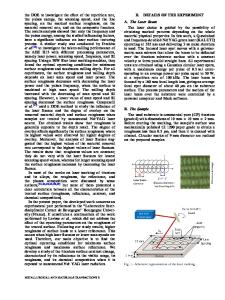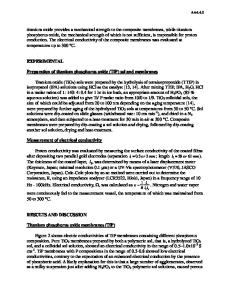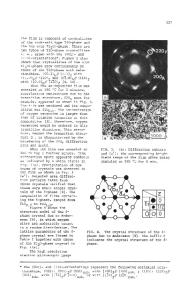Nanoporous Titanium Oxide Morphologies Produced by Anodizing of Titanium
- PDF / 3,181,376 Bytes
- 6 Pages / 612 x 792 pts (letter) Page_size
- 44 Downloads / 400 Views
R1.2.1
Nanoporous Titanium Oxide Morphologies Produced by Anodizing of Titanium G.P. Sklar, H. Singh, V. Mahajan, D. Gorhe, S.A. Namjoshi, and J.C. LaCombe Metallurgical and Materials Engineering University of Nevada, Reno Reno, NV, 89557, USA. ABSTRACT A quick and dependable technique has been developed that allows us to selectively produce anodized TiO2 in the form of nanotubes. The process employs mild chemical conditions and ambient temperature. The method can consistently produce nearly 100% surface coverage of nanotubes within 10 min of anodizing. Anodizing in relatively high pH electrolytes for 1 hour permitted us to produce nanotubes of 2µm length. We attribute the repeatability of our results to a brief pre-anodizing etching step that consistently leads to excellent anodizing results. Without this etching step, we experienced very poor consistency in that only small patches of titania nanotubes were formed. INTRODUCTION Titanium anodizing is an industrial process that has been used for more than half a century. Until recently, the improved corrosion resistance, anti-galling properties, increased fatigue strength, or improved bondability imparted by anodizing that was of primary interest. The oxide coatings formed are rough, non-porous barrier films, or, have a random pore structure if anodized above the breakdown voltage. Recently, it has been shown that titanium anodizing can provide a surface covered with titanium oxide nanotubes (TNTs). A good sense of the current state of this area of study can be found (for example), in [1-6]. These nanotubes are a selfassembled structure which may be of use for a variety of applications requiring nanometer scale features. BACKGROUND As introduced above, there is presently a growing interest in anodizing titanium. A selection of other reported efforts are briefly summarized below. HF, low pH Gong et al. [1] studied voltage variations and the influence on anodizing of TiO2 using 0.5 wt% HF. They reported that a 20 VDC anodizing voltage produced the best results for the formation of nanotubes. They reported virtually no increase of TNT lengths after approximately 20 minutes. They examined the process at 1.5 wt% HF and 20 VDC and observed the uniform TNT structure after only 8 minutes of anodizing. No mention was made of the percentage of the surface area that was successfully covered with TNTs.
R1.2.2
H2SO4—HF, low pH Beranek et al. [2], reported successful anodizing of TNTs using 20VDC in 1M H2SO4, 0.15 wt% HF, but the process required upwards of 24 hours to develop a uniform structure. No mention was reported of the percentage of the surface area that was covered. CrO3—HF, low pH Zwilling et al. [3] reported on their studies of TiO2 anodizing using 0.5M CrO3, 0.095M HF. They concluded that a porous TiO2 layer can be formed in a chromic acid solution in the presence of a small amount of HF and the TiO2 barrier oxide thickness is time independent whereas the thickness of porous TiO2 increases with anodizing time. This contrasted with the results of Gong et al. [1], b
Data Loading...










